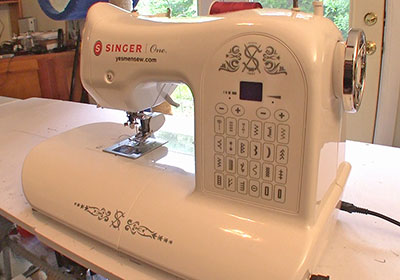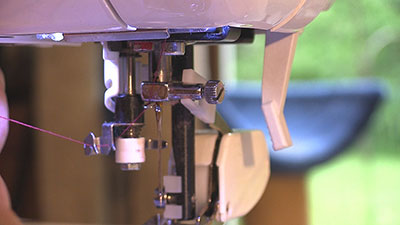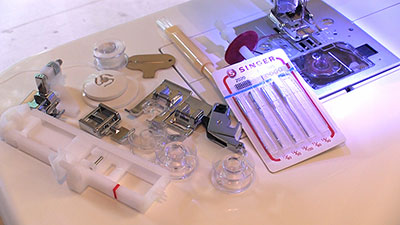 Home - How-To's - Reviews - Links - Contact - About Us
Home - How-To's - Reviews - Links - Contact - About UsOur other sites: FlyingRC.net - NewWoodworker.com - NewMetalworker.com
 Home - How-To's - Reviews - Links - Contact - About Us
Home - How-To's - Reviews - Links - Contact - About Us
Text, photos and video by Tom Hintz

Posted – 5-282019
The Singer ONE Vintage-Style Computerized Sewing Machine (in this Review called Singer ONE) was specifically designed for the home-sewing market. Though many will ask, it is not a heavy-duty, factory machine capable of sewing leather. However, it is capable of handling everything a rational home user will need. The Singer ONE may lack some creature comfort features but it also lacks an equal portion of price. If you want to buy sewing machine features you need rather than just want, read on.
The Singer ONE appears to have a heavy frame or a superior dampening system (or both) that dramatically reduces shake and vibration throughout the 750 stitches-per-minute speed range. There is no speed control other than the variable-speed foot pedal. Remember, smooth-running does not replace a solid work surface to put any sewing machine on, the Singer ONE included.
The Singer ONE dimensions are 23”-long by 10”-wide and 13”-tall. Though it looks and feels very substantial, the overall weight is just 23.9 pounds. Not a portable machine but one that poses no big issues bringing it out to use.
The Singer ONE has a generous 14-1/4”-long by 9”-wide work surface with a rounded perimeter and a bigger slope at the front to keep all types of fabric slipping along easily. The under-arm area is 6-1/4” needle to arm, and 5”-tall. This is fine for most sewing projects but could pose a bit of a problem with larger projects such as quilts depending on how you sew them.
Much of the work surface can be removed to access a surprisingly large free arm capacity. At 7”-long by 3-1/2” wide and 2-1/2”-tall this free arm should provide lots of working room for the largest of projects needing this type of access.
The work surface is evenly illuminated by three LED bulbs, two straddling the needle and another in the over arm. The light from these LEDs is soft, lacking the glare I have seen on some machines. The LEDs have an expected service life of 100,000 hours so keeping spares on hand isn’t high on the must have list.
A large slide out storage bin has plenty of room for a bunch of tools and notions in addition to the included accessories. The size of this bin is refreshing if you have dealt with the ridiculously small storage found on too many machines.
The Singer ONE is a low shank style machine and comes with an all-purpose foot, zipper foot, buttonhole foot, blind hem foot, satin stitch foot, a package of needles, five class 15J bobbins, thread spool caps, auxiliary spool pin, needle plate screwdriver, seam ripper/ lint brush, soft machine cover, introductory DVD, multi-lingual instruction manual (stitch guide included), quick start sheet, power cord and foot pedal control.
I added a Singer walking foot as I think a sewing machine is not complete without one. In our testing the Singer walking foot performed adequately.
The Singer ONE stitch selection includes 6 basic, 4 stretch, 12 decorative and 2 fully automatic, 1-step buttonhole stitch programs. All the stitches are accessed with blister-type buttons on the front of the machine. Singer’s marketing hyperbole gurus call this “One Touch” stitch selection. Sounds more expensive than “buttons”, even though these simple buttons have a cool LED behind them. Most modern machines with multiple stitches enable the most common length and width settings but the Singer folks call this “direct stitch selection”. Maybe they get paid by the syllable.
At the top of the stitch panel are controls for stitch length and width. After selecting a stitch, you can press either the + or – buttons once to see the current setting on the lighted display screen. Then use those buttons to change the stitch as you need for the job. A small light at the adjustment buttons shines red when the standard stitch settings are in force. When you alter those settings, the lights turn yellow.

I know I should have seen this coming, but those guru guys came up with another nifty label,” SwiftSmart” this time for an innovative thread path. The Singer ONE has a thin, single path for the thread from the spool to the needle. While I am curious about the mechanism that allows this thread path, I’m not about to start pulling covers off the Singer ONE to see. Something this simple on the outside just might be scary complex on the inside.
The Singer ONE auto needle threader is not significantly different from other systems on the market, but it does work well and is dependable. You do have to be sure to pass the thread through the guides before depressing the side-mounted lever to operate the mechanism and put the thread through the eye of the needle. Once you do it a few times it is easy.
A modern sewing machine without a drop-in bobbin makes the manufacturer look foolish. The Singer ONE has a drop-in bobbin plus they eliminated having to draw the bobbin thread up through the needle plate for sewing. The mechanism grabs the bobbin thread when you start sewing. Nice touch.
Bobbin winding is also familiar. Wrap the thread around a tensioning disk, through a hole in the bobbin and place it on the winding spindle. Sliding that spindle towards the limiting bar and the needle mechanism is disengaged while loading the bobbin.
Another nearly universal feature industry-wide has a new moniker on the Singer ONE. The “Presser Foot Sensor” makes a whimpy beeping noise while flashing the screen when the foot pedal is depressed when the presser foot is not lowered for sewing. The Singer marketing guys must have a bonus clause in their contract for cute terminology.
The 750 stitch per minute sewing speed might seem slow to some but in all the work I did with it, the maximum speed never was an issue. The speed is easy to control which makes it easier to be accurate throughout a project. I am always more interested in accuracy over pure speed.
The Singer ONE may not have a ridiculously long stitch list but it makes the ones it has cleanly at the default length and width settings. Nearly all stitches can be adjusted but all of them looked best at the default settings. The “brain” within the Singer ONE limits the stitch adjustments to prevent trying to stitch beyond the length and width limits of the needle mechanics. The speed at which each stitch is made is also controlled by the “brain” to get the best results.

The upper thread tension is adjustable but throughout my testing, the “auto” setting on the adjuster dial produced good stitching. That seemed to carry over through several different material and multiple-layer thicknesses.
Though I used a variety of material types, the feed system remained consistent. That is another reason the stitches, particularly the decorative ones turn out so crisp. The only issue I had during the evaluation was when laying down a line of decorative stitching on two layers of flannel the feed system did not get a good enough “bite”, because I started too close to the edge. That was my failure, not the machines. The fabric wadded up and forced me to remove the needle plate to get it out. I re did the same stitching, starting a little further in from the beginning edge of the same two-layer flannel and all went well. With the light canvas samples there were no feed issues even near the beginning edge. Not a big deal, rather a learning moment when working with soft flannel.
With the marketing hyperbole stripped away, the Singer ONE remains a solid machine for home sewing use. Its list of features may be smaller than some in this price range but brings everything most folks will need for real world home sewing. Too many potential buyers are swayed by huge stitch counts but will regularly use maybe 10 of them.
The Singer ONE runs smoothly and is consistent in its stitching which makes it easy to be accurate. There is more than enough power for virtually anything the home project list will produce. If you are looking for an industrial leather-capable machine, look elsewhere. If you want a good, capable sewing machine for home or hobby use take a hard look at the Singer ONE.
The Singer ONE sells for $229.99 (Amazon Prime, 5-10-2029) and is a good value for the money. No company exists for 160 years without producing products the marketplace likes. The Singer ONE is a good example of this and just one reason Singer will be around for a long time to come.
See ur video on this paroduct - Click Here
Have a comment on this Review? –Email Me!
All yesmensew.com written, photographic and drawn materials are property of and copyright by Tom Hintz and NewWoodworker.com LLC 2013-2019. Materials cannot be used in any way without the prior written permission of the owner.